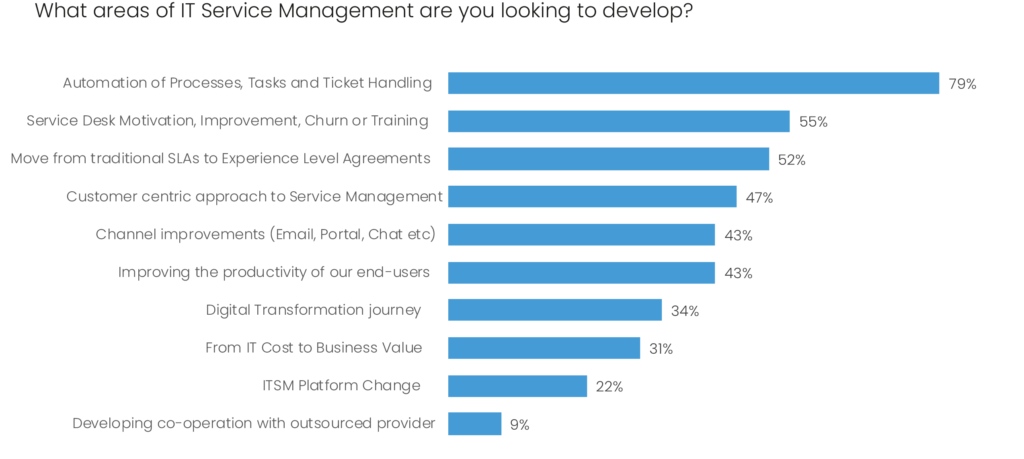2021 is almost upon us – or you might be reading this after it already is – and it raises questions around how IT service management (ITSM), or service management per se, will need to change. Or perhaps even how it will be forced to change to reflect the radically different world that we now live and work in. So, what are the important 2021 ITSM trends that we need to be addressing?
To help our collective understanding of service management’s likely future direction, we asked a number of ITSM-industry authorities to provide their opinions on the key 2021 ITSM trends and what’s needed for 2021 by asking them the following question:
In this article, a number of ITSM-industry authorities provide their opinions on the top three trends they expect to see in the world of #ITSM in 2021, along with advice to help Click To Tweet“What top three trends do you predict for the world of service management in 2021, and what advice can you provide for helping organizations to tackle these?”
We also requested that their responses didn’t overly cover the impact of homeworking that many of us still face for the foreseeable future, with this thought of as a given.
So, what did they say about 2021 ITSM trends? Please keep reading to find out more.

Akshay Anand – ITSM Product Ambassador and Evangelist, AXELOS
- Companies will be finally forced to meaningfully acknowledge and address employee mental health challenges as the COVID19 pandemic drags on. We’re already starting to see many friends and family suffering but soldiering on, but it’s only a matter of time before larger groups of people start calling in sick, or suffer from longer-term consequences of isolation.
- Companies and teams will find some sort of balance between working from home and meeting in a central location (which might not be an “office” in the traditional sense). Many organizations and individuals are starting to recognize the need for face-to-face interactions (whether professional or social) and are going to need to find creative ways to get teams together.
- Levels of automation in ITSM will rise significantly, resulting in further displacement of ITSM staff. At the same time, the replacement of human judgment, empathy, and cognition is going to lead to more severe technical outages and erosion of trust (in the IT department).

Karen Ferris – Change Management Consultant and Coach, karenferris.com
2021 ITSM TRENDS #1: Organizations that look after the mental wellbeing of their staff (including those in ITSM) will outperform their competitors. Resilience in the face of constant change will be a differentiator and competitive advantage.
ADVICE: The mental and physical wellbeing of ITSM staff has to be an organizational focus. The aftermath of COVID-19 will not be a walk in the park. Change will increase in velocity and disruption as we continue in our recovery from the biggest change we’ve ever encountered. Organizations should invest in their greatest asset – their people – and build a workforce that is resilient in the face of constant change. Those that do this effectively are the ones that know this is an ongoing journey – not a destination. The occasional workshop on resilience is not a solution. The demands on those working in ITSM increase due to the speed of change and therefore we have to invest in their resilience.
TREND 2: Adaptability. Adaptive leadership, adaptive teams, and adaptive employees will be key in 2021 and beyond. As the need for change increases through increased customer, consumer, and constituent demand; disruptive technology; and increased competition and innovation, organizations need the ability to continually adapt and flex to remain relevant in a continually changing world.
ADVICE: Get the adaptability advantage. Develop the ability to sense and respond; experiment rapidly, frequently, and economically; manage complexity; and change direction quickly. This entails the development of new leadership capabilities and organizational competencies.
TREND 3: Increasing focus on enterprise service management (ESM). It has been talked about for a long time, it’s now time for action. A key driver is the focus on the employee experience which needs to remove silos and increase collaboration.
ADVICE: Collaborate with the other support functions in the organization e.g. human resources (HR), finance, facilities etc. to utilize existing processes and tool capabilities to deliver seamless services to employees. This could mean a shared services approach or a cross-functional end-to-end onboarding and off-boarding process. Whatever the approach, it’ll lower costs, improve efficiencies, and improve the employee and customer experience.
The wellbeing of #ITSM staff has to be an organizational focus in 2021 says @KarenFerris. Organizations should invest in their greatest asset – their people – and build a workforce that is resilient to the constant change Click To Tweet
Jon Morley – Head of Service Delivery, Equifax UK
1. Greater reliance on digital technology and remote teams
Service management, like many other disciplines and industries, is no longer bound to the confines of a typical office. Due to a number of factors such as the COVID-19 outbreak, greater connectivity and technology, changing values, etc., reliance on digital and remote teams are more common today than ever before.
This increase in telecommuting is likely to present even more unique challenges for ITSM and influence the 2021 ITSM trends. For example, there may be more reliance on technology and suppliers to keep systems and communications flowing. Plus, service teams will need to be more lean and automated in their approach to processes, ticket resolution, and meetings.
Also, spontaneous collaboration, team-building, process alignment, and other service management tasks are simply more manageable when all members of the team are in proximity to each other.
Since the surge in remote work is likely to continue, ITSM practitioners must find ways to reduce friction or inefficiencies that might arise. Clear and open communication has always been a key strategy for effective ITSM, but it’ll become even more relevant as the work from home trend continues to evolve.
2. Leadership and soft skills
ITSM practitioners need a certain level of analytical and organizational skills in order to be effective in their roles, but their job does not end with the completion of tasks and documentation.
At the core of their work lies an understanding of people, process, and technology and how to manage them in a way that will yield the best results. For this reason, possessing an effective array of “soft skills” can be equally as important as specialist knowledge.
Effective ITSM practitioners need to be able to anticipate the needs of their team, understand their hopes and motivations, and identify and remove blockers before they impact any element of service.
Data from the World Economic Forum’s “Future of Jobs” report supports the need for these abilities, showing that social skills are ranked as one of the top skill sets employers look for in new hires and that this is likely to increase over time.
3. Integration with other strategic and delivery methods
ITSM has traditionally been seen as the “operational space” of the technology world, and in some cases this is still true. With the increase of digital development and expertise such as microservices, site-reliability engineering, and an ever-increasing need for continuous delivery/deployment, ITSM will have to increase its efforts to blend into these digital and DevOps-style areas, or risk being left behind.
While ITIL 4, VeriSM, and other approaches have gone some way to improving this, it’s still slow to permeate in some industries, that ITSM isn’t just about “support” or being a “customer” of projects, agile, and so on, but a key contributor to ensuring success.
The era of expecting teams to justify themselves to a sole change manager who has 20 years of experience of telling people to go to the change advisory board (CAB) and fill in 12 pages of a change template is over. The era of product owners, self-managing teams, and quicker delivery to market is here, and it’s only going to ramp up.
Clear and open communication has always been a key strategy for effective #ITSM, but it’ll become even more relevant as the work from home trend continues to evolve in 2021 – @JonMorleyITSM Click To Tweet
Peter Brooks – Service Governance Consultant, Independent
1. Deeper concern with risk and sustainability
Advice: Examine what went wrong in the covid experience that demonstrated the status quo was inadequate. Consider rewriting governance to enable sustainability in the future, perhaps with more emphasis on anti-fragile design than resilience and continuity. Now that it’s clear that Black Swans can turn up, even if they’re only expected once a century, what other Black Swans should each particular industry and company consider planning to mitigate? How is it possible to become more antifragile without overreacting to unlikely risks? Which governance values need to be embedded, by changing culture, to future-proof the organization?
2. Confusion about how value has changed
Advice: Rediscover who stakeholders actually are. Consider how the outcomes they expect and need have changed in the new reality. Look at the much bigger picture of a recovering world economy and the opportunities there are to uncover and meet new demand for different outcomes – build value generation scenarios and design services to support them.
3. Reevaluation of strengths and weaknesses
Advice: Are the organization’s objectives and goals still relevant? Are some things previously considered weaknesses now strengths and vice versa? For example, a decentralized structure (home working brings the extreme) may have seemed too expensive and risky, but is now being viewed as an anti-fragile strength. Just in time manufacturing and supply chains seemed the way of the future, now they are seen as a disaster. How to find a middle ground between JIT and inefficient stockpiling? Can new technology, like 3D printing, unlock reliance on extended supply chains?
I know these are closer to service governance issues than traditional IT-focused ITSM, but this crisis should have shown that traditional ITSM is not effective, unless coupled to organizational governance very tightly – both ways, affecting governance and adopting changes to governance in an agile manner (small ‘a’ as Rob England likes to say).
The global crisis should have shown us that traditional ITSM is not effective, unless coupled to organizational governance very tightly – @fustbariclation #ITSM #governance #COVID19 Click To Tweet
Madhu Nair – Director, Product Marketing, Freshworks
COVID-19 and the resulting pandemic is a rude reminder that what we think of as scale and urgency in normal times is not big enough, nor urgent enough. As organizations that consume service management for our employees and as providers of service management solutions, suddenly we find ourselves bringing out capabilities that are elegant, deep, and are used at unmatched scale and pace. Service management has also emerged as a critical life-saving safety net – as we navigate the knowledge and the gig economy – and is valiantly holding together business operations, employee productivity, and employee experience.
This shift in emphasis and the realization by business leaders of the increased importance of service management, in turn, will force us to take a long hard relook at some of our key pillars such as artificial intelligence (AI), employee experience, and service management frameworks beyond rhetoric.
2021 ITSM trends will force us to:
- De-emphasize the artificial and amp up the intelligence – Python code and automation is only the stepping stone to true intelligence. Business organizations and service management providers need to dive into the deep end of AI with the heavy artillery of sophisticated modeling, harnessing big data techniques, obsessing after prediction accuracies, and using massive data sets. The quality of AI suggestions, and its delivery mechanism, will become differentiators going forward. Be it improving accuracy rates of solution suggestions, automatically pre-empting service disruptions, or identifying vulnerability in knowledge or the consumption of services, intelligence built into ITSM tools should hit scale and sophistication.
- Build for scale and scope, but with simplicity – One thing the pandemic has taught us is that there’ll always be pockets of service management that need custom building. There are simply too many scenarios, flavors, and combinations of services that originate within a business. Can one solve for it all out-of-the-box? I’ll stick my neck out and say no. But should service management solutions build to accommodate any variation in their platform? An emphatic yes. Service management solutions will be faced with the competing priorities of usability and versatility. Whoever closes this gap the most effectively will win.
- Redefine the boundaries of service management – At the very least, classic service management’s scope will merge into those of operations management, SaaS management, and employee wellbeing and happiness. The sooner you start down the path of treating this “greater service management” landscape as an interconnected whole, the more effectively and comprehensively you can solve many problems. Service management capabilities will also evolve from being primarily risk mitigators to value drivers. For example, SaaS spend identification and optimization will evolve into a SaaS software recommendation and selection engine. Operations management solutions can share rich service catalogs and asset libraries with service management solutions. This deep integration with adjacent boundaries of service management will define how service management looks in the coming year and the associated 2021 ITSM trends.

Martin Goble – Global SIAM Competency Lead, Tata Consultancy Services
Service management is difficult and it’s only going to get harder. Organizations are getting more complex as they move to adopt agile (and DevOps) ways of working. Now, in terms of 2021 ITSM Trends, service management needs to adapt to work effectively in these hybrid operating models where some teams follow the traditional Application Development/ Application Support/ Infrastructure Operations model while others move to Agile DevOps frameworks.
We need to consider a mindset-led service management approach, where service management moves from a “control and govern” to a “coaching and enabling” way of working.
Rather than a service management team of process managers, we envisage a service management function that supports and enables processes within the organization, driving some processes (inside-out) while facilitating other processes that are driven by business need (outside-in), providing service management coaching to product teams, alongside more traditional process managers.
In 2021, we need to consider a mindset-led service management approach, where service management moves from a control and govern to a coaching and enabling way of working – @ITILPunk #ITSM Click To Tweet
Roy Atkinson – CEO/Principal Advisor, Clifton Butterfield, LLC
2021 ITSM trends #1: Continued and increasing emphasis on IT as a capability rather than a department.
Technology now permeates organizations, as does the kind of expertise needed to make it work.
Trend 2: Increasing awareness that customer experience (CX) is dependent on everyone in the organization, “techies” included. In response to a recent research survey from HDI, 77% of organizations said that CX was the primary factor for moving toward enterprise service management, for example.
Trend 3: Organizations will continue to blend frameworks and methodologies, adopting and adapting approaches that are relevant to their culture and goals.
Advice: For organizations to continue benefiting from these 2021 ITSM trends, employees need to be provided with access to relevant bits of training (micro-training) to learn as they go. Referring back to 2021 ITSM Trend 1: It wouldn’t be effective for an HR staffer to spend three days learning an “IT” service management framework in toto, but spending an hour or two learning about value chains or “The Three Ways” would likely be beneficial. (It’s important that training organizations provide these micro-training modules if they wish to remain viable.)
In 2021, we’ll see a continued and increasing emphasis on IT as a capability rather than a department. Technology now permeates organizations, as does the kind of expertise needed to make it work – @RoyAtkinson #ITSM Click To Tweet
Rina Tini – Program Manager, The New York City Department of Information Technology & Telecommunications (DoITT)
- I strongly feel there’ll be more companies utilizing the ITIL framework, and providing training to their staff as I’m already seeing the pattern as the reliance on technology and IT demands are increasing overall.
- There’ll be more effort towards simplifying IT processes, including the role that the service desk plays to support customers and users.
- The chaos will continue as we continue through the pandemic, with the need to find the balance between ‘cost of ownership’ and ‘return on investment’. In recent times, I’ve seen/heard of budget cuts and layoffs among IT staff, so the demand for streamlining/cost savings will continue to be a hot topic in the IT industry.

Sami Kallio – CEO, HappySignals
2020 has brought new challenges to the ITSM world that no one ever expected. However, the efforts to ensure a smooth and consistent IT experience during the pandemic didn’t go unnoticed, with multiple studies reporting positive results.
A survey conducted by ITSM.tools showed 66% of IT workers felt their personal efforts during the pandemic were recognized by management to some degree.
In Gartner’s 2020 Digital Workplace Survey, 68% of respondents agreed C-level execs expressed more involvement in the digital workspace than before the pandemic.
These surveys are well aligned with our ongoing collection of Happiness Score™ data.
In our recently published Q3/2020 Happiness Score™ Report, we found that end user happiness with IT services increased, after an initial drop, and our global Happiness Score™ showed higher levels of experienced satisfaction with IT than before the pandemic.
My 2021 ITSM trends are:
Experience-driven IT leadership
We’ve seen great examples of experience-driven IT leadership that carried organizations through 2020 with increased levels of happiness. Sophos utilized experience data throughout the pandemic to listen to how their end users are experiencing services and tailor solutions to meet their needs, even by supplying new equipment through couriers.
Creating an experience-centric mindset focuses your goals on outcomes instead of outputs, how you can create greater productivity for your end users, and essentially provide business value through IT.
So, what should successful IT teams focus on in 2021?
In 2021, being a strategic partner to the business can be achieved by focusing on three elements that drive employee happiness and increase productivity.
- Employee experience – The importance of understanding employees’ needs will continue to grow in the hybrid workplace. If COVID-19 has taught us anything, it’s that circumstances can change quickly and dramatically, as well as end-users’ needs. Continuous measurement of end-user experience is vital in order to adapt and adjust strategies and services quickly when needed to.
- Outcome-focused empathy and purpose – By understanding employee needs, focus shifts from outputs to meaningful outcomes, from checking off to-do lists to working towards common goals. IT leaders should have a clear purpose on the outcome of projects and how this will impact end users in terms of a positive experience. Creating projects that make a difference for your end users will also boost motivation and cooperation among your IT teams and partners.
- Data – The increasingly strategic role of IT also means increased scrutiny, emphasizing the need for data to show the actual contribution of IT in an organization. Experience data enables IT departments to get rid of gut feelings and focus on what really needs to be fixed or improved from end-users’ perspectives.
The outcome of this, supported by our data, is happier employees that are more productive. What else could one wish for as we look ahead?
The importance of understanding employees’ needs will continue to grow in the hybrid workplace - @SamiKallioHki #ITSM #EX Click To Tweet
Sanjeev NC – Product Manager, SuperOps.ai
In terms of 2021 ITSM trends, I expect more focus on digital hygiene, personal knowledge management, and increased dependency on digital tools. We can safely assume it’s become much harder for anyone to have a ‘quick-conversation’ in person. Therefore, you can expect a rise in the number of digital interactions through emails, pings, and tickets. If individuals are not able to manage the inflow of information coming their way, they’re going to end up in a digital mess. Tribal knowledge will be surfaced digitally and if individuals don’t have a system in place to manage them, they’ll become unusable and eventually lost. If a messy desk is any indication of how hard it gets to work, a digital mess is only 10 times worse. Digital hygiene should be advocated and processes should cease to exist for process sake but to actually help individuals get more work done. Tools, at a personal level, will be recognized as a necessity and not merely a ‘good-to-have’.
In 2021, I expect more focus on digital hygiene, personal knowledge management, and increased dependency on digital tools – @SanjeevNC #ITSM Click To Tweet
Scarlett Bayes – Senior Research Analyst, SDI Institute
Earlier this year at SDI, we asked service desk professionals what their main focuses were and, as we can see in the chart, the top three topics centered around automation, staff development, and customer experience.
These sorts of topics are ones we see come up again and again with ITSM, as we do with many others, so pinpointing what the top three 2021 ITSM trends will be for next year is no easy task. I could very well say metrics, enterprise service management, and Shift-Left, and I could still be accurate. If I asked our marketing team, they might say AI, wellbeing, and best practices. I suppose my point is that it’s all relative and, to some extent, these trends are interlinked. For example, in order to talk about AI you need to talk about automation, and to talk about automation you need to talk about staff development, which leads you into Shift-Left, then into CX, and so on. But to answer the question laid out at the top of this blog, let’s take the top three trends that the industry professionals have said they will be focusing on.
1. Automation
The basics of preparing your IT service desk for automation is well documented, but the main advice I’d give is to avoid automating inefficiency. Review your processes and remove any “waste” procedures and find the areas where processes cross over, i.e. where they could be integrated. Not only does this increase the efficiency of IT, but it also highlights exactly what can be automated, potentially making the automation process easier.
2. Staff Development
SDI’s latest Benchmarking Report showed that the length of time service desk analysts stay in their role on average has increased, and higher proportions stay within the organization after leaving the IT service desk. Alongside more opportunities for promotion and higher rates of ongoing training, it’s possible that organizations are implementing technology that requires higher-skilled staff, and they’re investing time and budget into developing their staff in order to evolve alongside the technology.
Developing your staff is usually my advice for preparing to implement new technologies or frameworks. To achieve this, knowing your service desk’s current skill set, figuring out the skills your staff need (as well as simply asking your staff what skills they want to develop), and utilizing career progression plans can all get you started with staff development.
3. CX (please note that SDI views employees as customers)
CX is perhaps one of my favorite topics to talk about, and it’s a topic that feeds into so many other trends within ITSM. Over the years, it has transcended past simply measuring your customer satisfaction and has evolved into centring your service around your customers. There’s so much more that goes into CX than the metric alone, including actively monitoring CX levels to understand what affects your customers’ experience the most, mapping your customers’ journeys and how they interact with your service, proactively using the data to make decisions and fuelling continual improvement, and including your customers in strategy planning and implementations to educate them and also gain valuable feedback. We’re now discussing things like Experience Level Agreements (XLAs) and Balanced Scorecards to gear service level monitoring to be more customer-centric.
I could harp on about the benefits of customer-centricity all day, but my main piece of advice for IT service desks in this respect would be to pull together a group of customer representatives from different areas of the business to get some fast, actionable feedback about how to improve and become more customer-focused. If this isn’t feasible, there’s likely a goldmine of information in customer feedback surveys, and you can utilize this to kickstart customer-centric continual improvement.
Overall, 2020 has been an interesting year for ITSM, to say the least. It’s led to a lot of IT service desks needing to go back to basics to understand how to continue to provide vital services in a completely different capacity. Next year, we’ll hopefully begin to rebuild on these new foundations and come out the other side stronger, more valued, and in a better position to support the business.
According to @SDI_Institute research, the top 3 areas people in #ITSM are looking to focus on in the year ahead are #automation, staff development, and #CX, says @SDI_Scarlett Click To Tweet
Vawns Murphy – Lead IT Partner – Service Delivery, Silva Homes
I think we can all agree that getting the hell out of 2020 is a solid plan. We’ve had corona time, we’ve had the “new normal,” and we’ve even had situations where we’ve had some normalcy and then gone back to “lockdown light.” So what do we do now? How do we even begin to move forward when the world feels like some sort of dystopian alternate reality? Honestly? I’m going to keep drinking coffee and cuddling my children as much as I can, but aside from that, here are three things – the 2021 ITSM trends – that I’m going to focus on in 2021.
1. Empathy
People are everything – they really are. One of the most important things that the last year has taught me is how we need to look out for each other. Practicing empathy isn’t just a few platitudes; it’s a vital way of being able to communicate with and look after your colleagues and your customers. We can all do this by:
- Looking after our colleagues. We still don’t know the full impact that COVID-19 has had on mental health but I think we can all agree that it’s been a rough time. Make sure that everyone has access to support. If your company has an employee assistance plan, fantastic. Make sure the contact details are readily available such that if someone needs help they don’t have to worry about finding an obscure number, web address, or passcode. If you don’t have a helpline, one option to consider is a buddy system whereby people have someone to talk to if it all gets too much.
- When dealing with customers, remember that the person you’re supporting is potentially someone who’s vulnerable or scared. Take the time to let people vent and be patient if someone is struggling.
- Ask your team if they’re OK and mean it. People are complicated and sometimes it can be really hard to talk about how you’re feeling. I get that I really do. I’ve told people everything was grand and then gone to cry in the bathroom or given myself pep talks in the car park. So it’s one thing to ask if someone’s OK, it’s another to make sure. Take a minute to connect with the people around you. If someone looks like they’re having a rough day, then ask them if they want to grab five minutes and get a coffee. Check-in with the people you know are struggling.
2. A new appreciation for business continuity
If you’d told me a year ago that we’d be dealing with a global pandemic I wouldn’t have believed you. Most continuity plans I’ve seen focus on things like natural disasters, acts of terrorism, or key people being unable to access the office. They’re also usually big, clunky, unwieldy documents. A continuity plan only works if the business can truly keep going while following it, so here are some things to consider:
- Stop focusing on physical sites and pieces of tin over people and services. The office is no longer a physical building – for many roles it doesn’t matter if you can’t get to it as long as you have a laptop or tablet and network connectivity.
- Use the past year to sense check what your critical services are. The service catalog or service level agreement (SLA) may say something is critical but ask yourself this – what services were used most by the business during lockdown? What were the most common tickets logged with the IT service desk? What were the services most requested? Make sure what’s documented matches reality so the services most critical to the business are flagged and treated as such.
- If you have an existing continuity plan, ask yourself: was it followed? What went well and was there anything that could have been improved on?
- If you don’t have a continuity plan, talk to your teams and document everything you’ve done so far in response to COVID-19.
- We need to blend agility into our continuity planning. The way we work has changed and very rigid, detailed instructions are not going to be helpful. Instead, we need to focus on key outcomes and the roles and functions needed to deliver them. Make sure your plan has a decision-making framework and identifies the key contacts and supporting personnel, asset details, and communication protocols for the organization to fall back on if the worst should happen again.
3. New skill sets
The way we provide support has changed and we need to look at ways to maintain CX. We’ve moved from a mixture of in-person and remote support to pretty much remote support only and that’s a skillset in itself. It’s a very different experience from both a tech and end user perspective, providing support remotely rather than in person. Installing software, entering admin credentials, even restarting can be more challenging when you’re not sitting in front of the device in question, so what can we do to make things better?
- Make sure everyone on your IT service desk is comfortable using whatever remote support tool you have so that everyone can use it effectively.
- Make the provision of remote support easier on end users by having some guidelines on what they may need to do in order to get support. In an ideal world, you could find the person and connect in the background but occasionally the tool won’t cooperate, something will glitch, or the usual methods won’t work. Have a tutorial on ways for customers to identify their asset tag, IP address, or even how to launch Quick Assist (if everything else has failed).
- Use active listening so you can understand and verify what the end user is reporting. People might be overworked and stressed in these strange times and it’s incredibly easy to miss something important during busy times. Sense check what the person is reporting so that you can ask relevant follow up questions and provide more effective support.
- As you’re working on the issue, talk the user through each step and share any relevant knowledge articles so the person has the option to use self help.
- Use quiet time effectively. There is nothing more disconcerting than total silence when you’re on a call so if you’re waiting for something to install or the device to restart take the time to recap what you’re doing, check the person’s asset tag, and ask if there’s anything else needed from a support perspective.
So, that’s what all these fine people think will be most important in 2021 – the 2021 ITSM trends. There’s definitely a lot of commonality – for example, wellbeing and resilience. But what do you think? Please let me know in the comments.
Sophie Danby
Sophie is a freelance ITSM marketing consultant, helping ITSM solution vendors to develop and implement effective marketing strategies.
She covers both traditional areas of marketing (such as advertising, trade shows, and events) and digital marketing (such as video, social media, and email marketing). She is also a trained editor. Y


